Janus Type Monolayers of S-MoSiN2 Family and Van Der Waals Heterostructures with Graphene: DFT-Based Study
Abstract
:1. Introduction
2. Optimization and Stability of Structures
3. Electronic Properties of Structures
4. Van Der Waals Heterostructures with Graphene
5. Conclusions
Author Contributions
Funding
Data Availability Statement
Conflicts of Interest
References
- Hong, Y.-L.; Liu, Z.; Wang, L.; Zhou, T.; Ma, W.; Xu, C.; Feng, S.; Chen, L.; Chen, M.-L.; Sun, D.-M.; et al. Chemical vapor deposition of layered two-dimensional MoSi2N4 materials. Science 2020, 369, 670–674. [Google Scholar] [CrossRef] [PubMed]
- Novoselov, K.S. Discovery of 2d van der Waals layered MoSi2N4 family. Natl. Sci. Rev. 2020, 7, 1842–1844. [Google Scholar] [CrossRef] [PubMed]
- Wang, L.; Shi, Y.; Liu, M.; Zhang, A.; Hong, Y.-L.; Li, R.; Qiang, G.; Chen, M.; Ren, W.; Cheng, H.-M.; et al. Intercalated architecture of MA2Z4 family layered van der waals materials with emerging topological, magnetic and superconducting properties. Nat. Commun. 2021, 12, 1–10. [Google Scholar]
- Zhong, H.; Xiong, W.; Lv, P.; Yu, J.; Yuan, S. Strain-induced semiconductor to metal transition in MA2Z4 bilayers (M= Ti, Cr, Mo; A= Si; Z= N, P). Phys. Rev. B 2021, 103, 085124. [Google Scholar] [CrossRef]
- Akanda, M.; Karim, R.; Lake, R.K. Magnetic properties of NbSi2N4, VSi2N4, and VSi2P4 monolayers. arXiv 2021, arXiv:2105.01857. [Google Scholar] [CrossRef]
- Li, B.; Geng, J.; Ai, H.; Kong, Y.; Bai, H.; Lo, K.H.; Ng, K.W.; Kawazoe, Y.; Pan, H. Design of 2d materials–MSi2CxN4-X (M = Cr, Mo, and W; x = 1 and 2)–with tunable electronic and magnetic properties. Nanoscale 2021, 13, 8038–8048. [Google Scholar] [CrossRef]
- Mortazavi, B.; Javvaji, B.; Shojaei, F.; Rabczuk, T.; Shapeev, A.V.; Zhuang, X. Exceptional piezoelectricity, high thermal conductivity and stiffness and promising photocatalysis in two-dimensional MoSi2N4 family confirmed by first-principles. Nano Energy 2021, 82, 105716. [Google Scholar] [CrossRef]
- Yu, J.; Zhou, J.; Wan, X.; Li, Q. High intrinsic lattice thermal conductivity in monolayer MoSi2N4. New J. Phys. 2021, 23, 033005. [Google Scholar] [CrossRef]
- Sibatov, R.T.; Meftakhutdinov, R.M.; Kochaev, A.I. Asymmetric XMoSiN2 (X = S, Se, Te) monolayers as novel promising 2D materials for nanoelectronics and photovoltaics. Appl. Surf. Sci. 2022, 585, 152465. [Google Scholar] [CrossRef]
- Zhang, J.; Jia, S.; Kholmanov, I.; Dong, L.; Er, D.; Chen, W.; Guo, H.; Jin, Z.; Shenoy, V.B.; Shi, L.; et al. Janus monolayer transition-metal dichalcogenides. ACS Nano 2017, 11, 8192–8198. [Google Scholar] [CrossRef] [Green Version]
- Taghinejad, H.; Rehn, D.A.; Muccianti, C.; Eftekhar, A.A.; Tian, M.; Fan, T.; Zhang, X.; Meng, Y.; Chen, Y.; Nguyen, T.V.; et al. Defect-mediated alloying of monolayer transition-metal dichalcogenides. ACS Nano 2018, 12, 12795–12804. [Google Scholar] [CrossRef]
- Taghinejad, H.; Eftekhar, A.A.; Adibi, A. Lateral and vertical heterostructures in two-dimensional transition-metal dichalcogenides. Opt. Mater. Express 2019, 9, 1590–1607. [Google Scholar] [CrossRef]
- Rezavand, A.; Ghobadi, N. First-principle study on quintuple-atomic-layer Janus MTeSiX2 (M= Mo, W; X= N, P, As) monolayers with intrinsic Rashba spin-splitting and Mexican hat dispersion. Mater. Sci. Semicond. Process. 2022, 152, 107061. [Google Scholar] [CrossRef]
- Smidstrup, S.; Markussen, T.; Vancraeyveld, P.; Wellendorff, J.; Schneider, J.; Gunst, T.; Verstichel, B.; Stradi, D.; A Khomyakov, P.; Vej-Hansen, U.G.; et al. QuantumATK: An integrated platform of electronic and atomic-scale modelling tools. J. Phys. Condens. Matter 2019, 32, 015901. [Google Scholar] [CrossRef]
- Van Setten, M.J.; Giantomassi, M.; Bousquet, E.; Verstraete, M.J.; Hamann, D.R.; Gonze, X.; Rignanese, G.-M. The PseudoDojo: Training and grading a 85 element optimized norm-conserving pseudopotential table. Comput. Phys. Commun. 2018, 226, 39–54. [Google Scholar] [CrossRef] [Green Version]
- Perdew, J.P.; Burke, K.; Ernzerhof, M. Generalized gradient approximation made simple. Phys. Rev. Lett. 1996, 77, 3865–3868. [Google Scholar] [CrossRef] [Green Version]
- Malyi, O.I.; Sopiha, K.V.; Persson, C. Energy, phonon, and dynamic stability criteria of two-dimensional materials. ACS Appl. Mater. Interfaces 2019, 11, 24876–24884. [Google Scholar] [CrossRef]
- Putungan, D.B.; Lin, S.-H.; Kuo, J.-L. A first-principles examination of conducting monolayer 1t’-MX (M = Mo, W; X = S, Se, Te): Promising catalysts for hydrogen evolution reaction and its enhancement by strain. Phys. Chem. Chem. Phys. 2015, 17, 21702–21708. [Google Scholar] [CrossRef] [Green Version]
- Calandra, M. Chemically exfoliated single-layer mos2: Stability, lattice dynamics, and catalytic adsorption from first principles. Phys. Rev. B 2013, 88, 245428. [Google Scholar] [CrossRef] [Green Version]
- Heyd, J.; Peralta, J.E.; Scuseria, G.E.; Martin, R.L. Energy band gaps and lattice parameters evaluated with the Heyd–Scuseria–Ernzerhof screened hybrid functional. J. Chem. Phys. 2005, 123, 174101. [Google Scholar] [CrossRef]
- Sibatov, R.T.; Golmankhaneh, A.K.; Meftakhutdinov, R.M.; Morozova, E.V.; Timkaeva, D.A. Modelling of electron and thermal transport in quasi-fractal carbon nitride nanoribbons. Fractal Fract. 2022, 6, 115. [Google Scholar] [CrossRef]
- Idrees, M.; Din, H.U.; Rehman, S.U.; Shafiq, M.; Saeed, Y.; Bui, H.D.; V Nguyen, C.; Amin, B. Electronic properties and enhanced photocatalytic performance of van der Waals heterostructures of ZnO and Janus transition metal dichalcogenides. Phys. Chem. Chem. Phys. 2020, 22, 10351–10359. [Google Scholar] [CrossRef] [PubMed]
- Idrees, M.; Din, H.U.; Ali, R.; Rehman, G.; Hussain, T.; Nguyen, C.V.; Ahmad, I.; Amin, B. Optoelectronic and solar cell applications of Janus monolayers and their van der Waals heterostructures. Phys. Chem. Chem. Phys. 2019, 21, 18612–18621. [Google Scholar] [CrossRef] [PubMed]
- Yu, S.; Wei, W.; Li, F.; Huang, B.; Dai, Y. Electronic properties of janus MXY/graphene (M = Mo, W; X≠ Y = S, Se) van der waals structures: A first-principles study. Phys. Chem. Chem. Phys. 2020, 22, 25675–25684. [Google Scholar] [CrossRef] [PubMed]
- Meftakhutdinov, R.M.; Sibatov, R.T.; Kochaev, A.I.; Evseev, D.A. First-principles study of graphenylene/MoX2 (X = S, Te, and Se) van der Waals heterostructures. Phys. Chem. Chem. Phys. 2021, 23, 14315–14324. [Google Scholar] [CrossRef]
- Meftakhutdinov, R.M.; Kochaev, A.I.; Sibatov, R.T. Graphenylene/Janus transition metal dichalcogenides XMoY (X and Y = S, Te, Se) as a new van der Waals heterostructures for optoelectronic applications. Phys. E Low-Dimens. Syst. Nanostructures 2022, 143, 115305. [Google Scholar] [CrossRef]
- Cao, L.; Zhou, G.; Wang, Q.; Ang, L.K.; Ang, Y.S. Two-dimensional van der Waals electrical contact to monolayer MoSi2N4. Appl. Phys. Lett. 2021, 118, 013106. [Google Scholar] [CrossRef]
- Grimme, S. Semiempirical GGA-type density functional constructed with a long-range dispersion correction. J. Comput. Chem. 2006, 27, 1787–1799. [Google Scholar] [CrossRef]
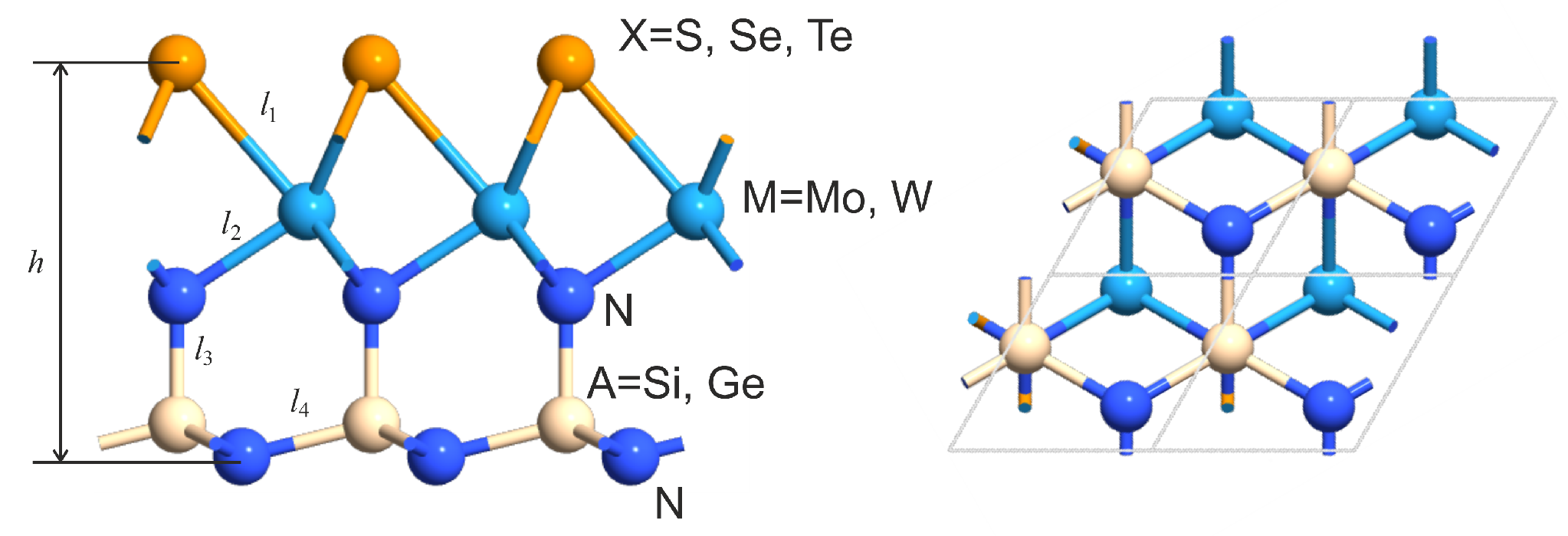
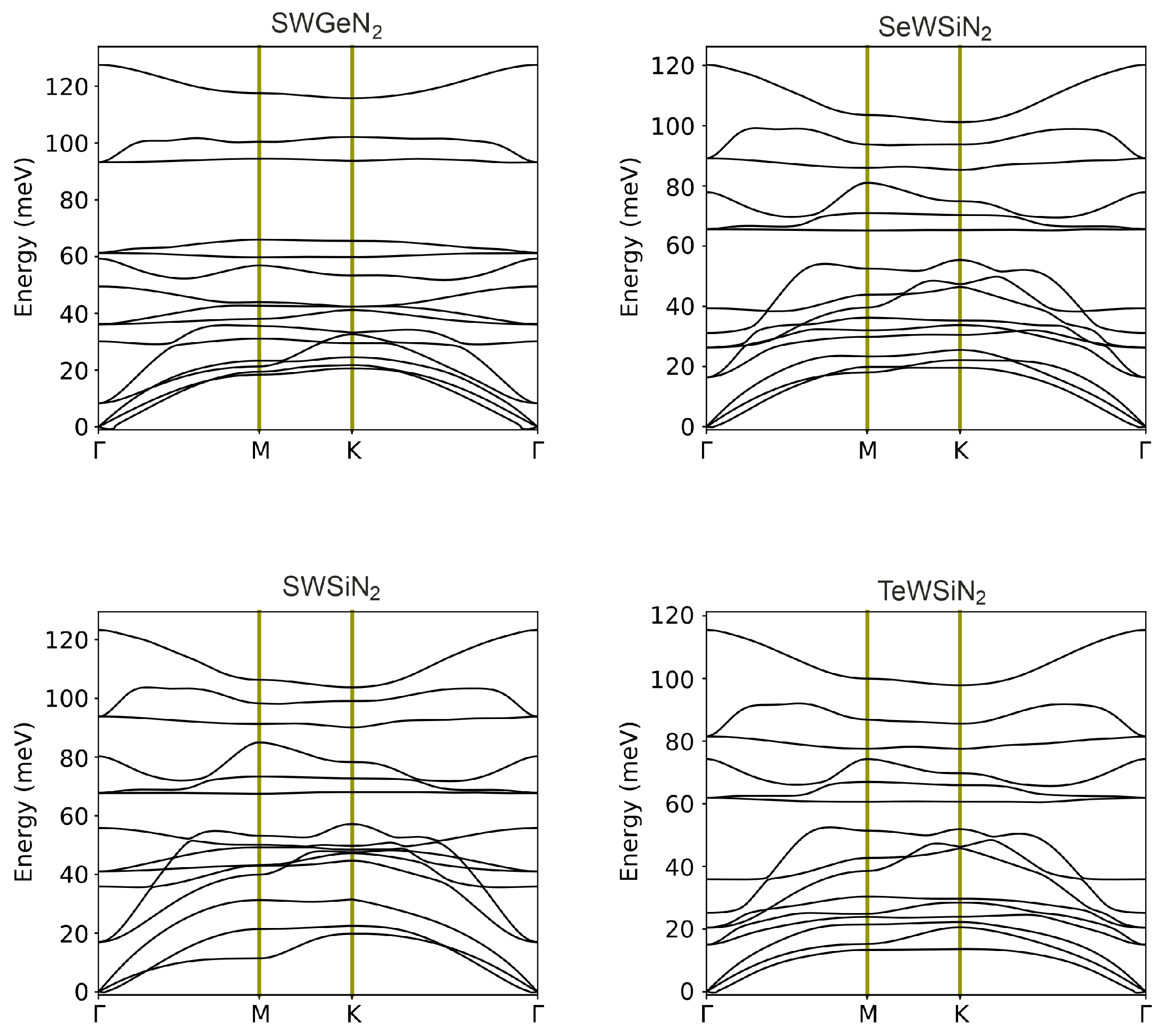
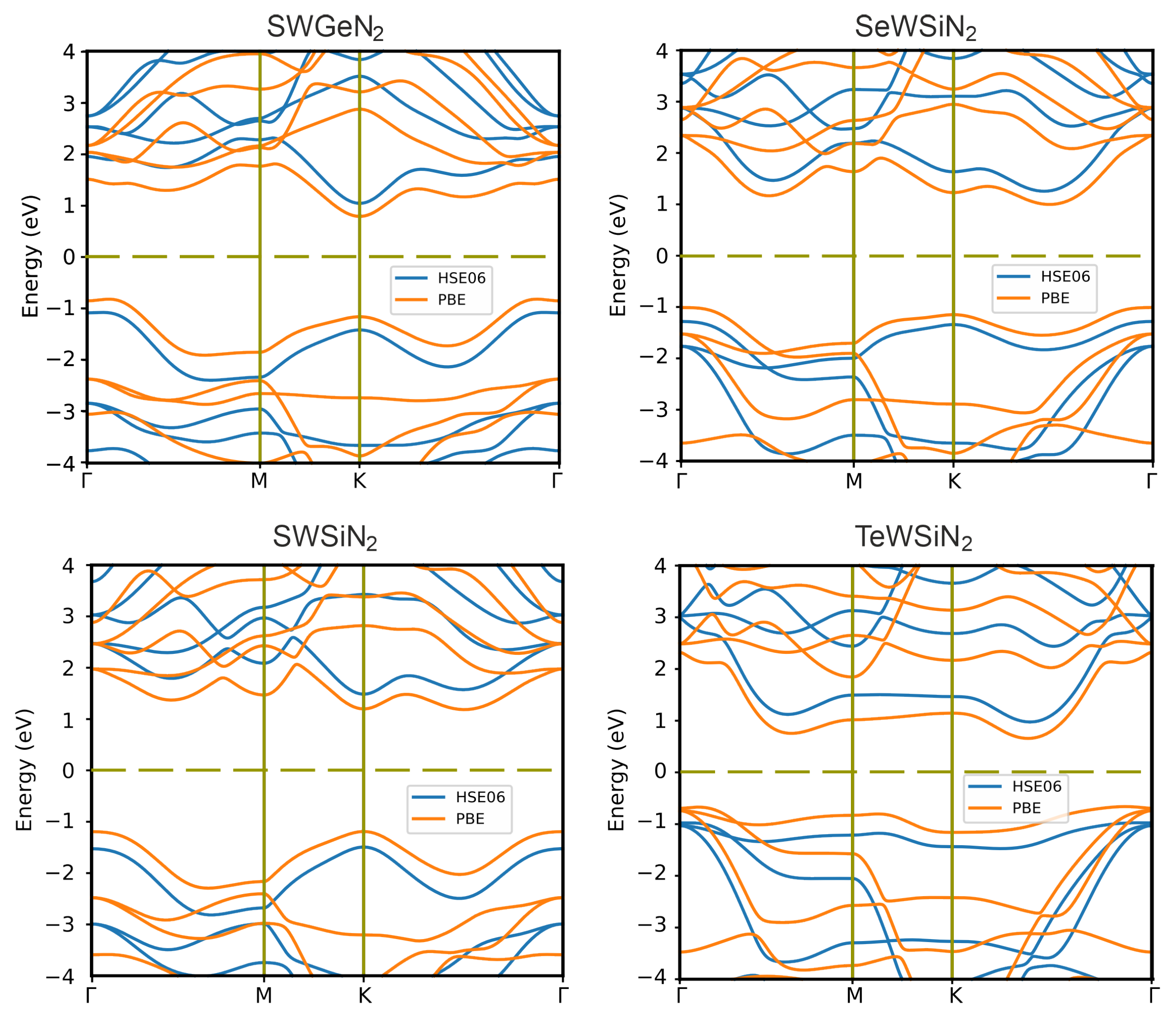


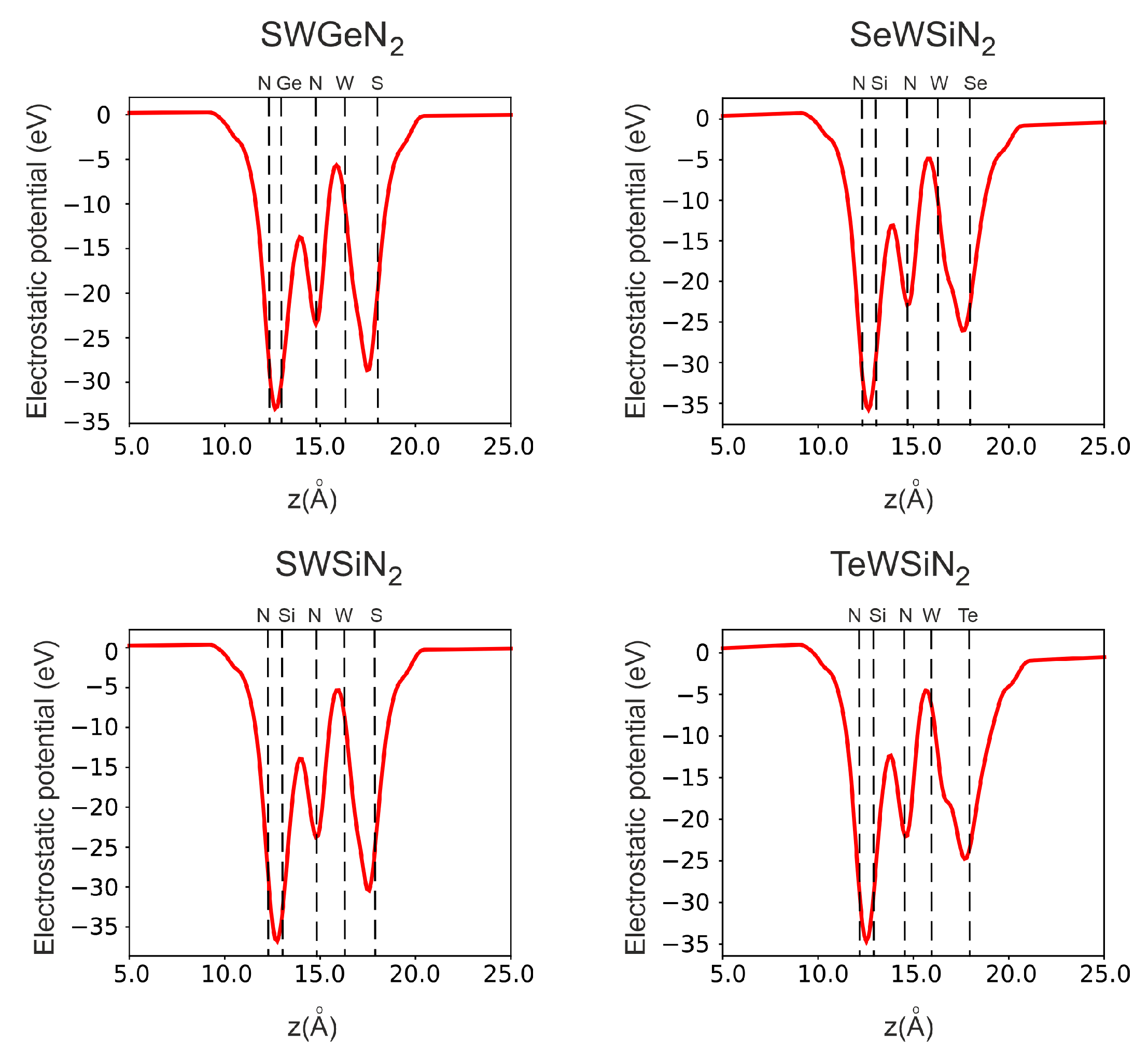

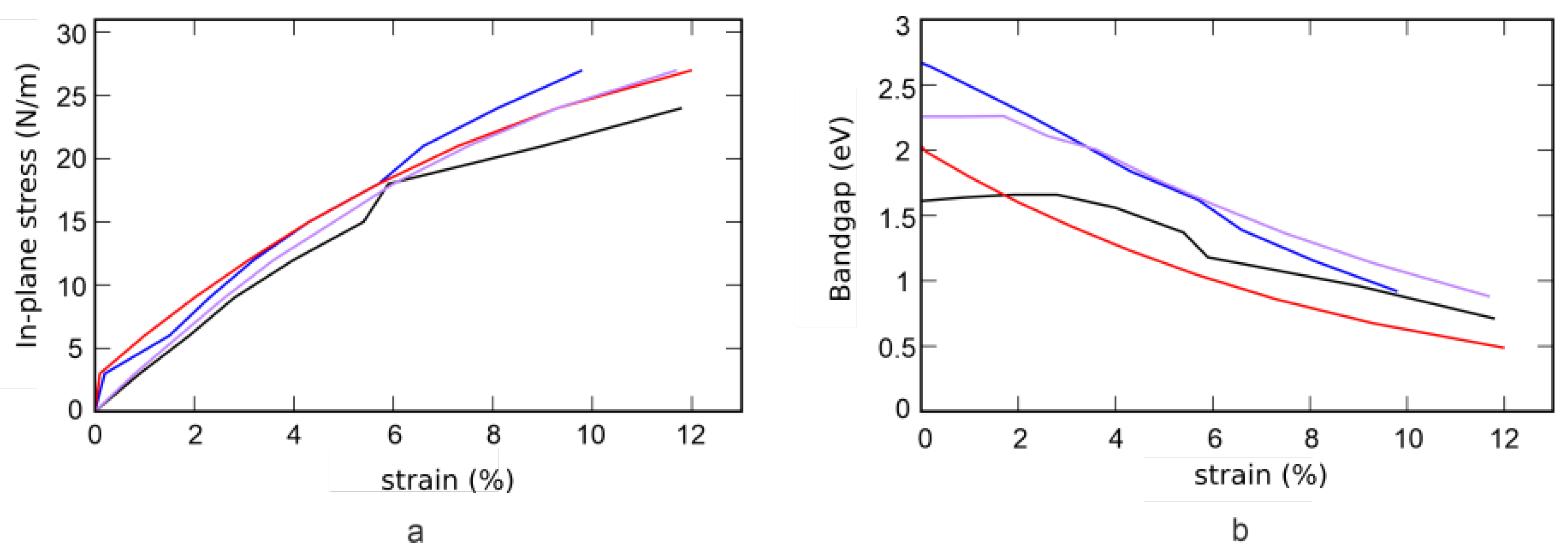
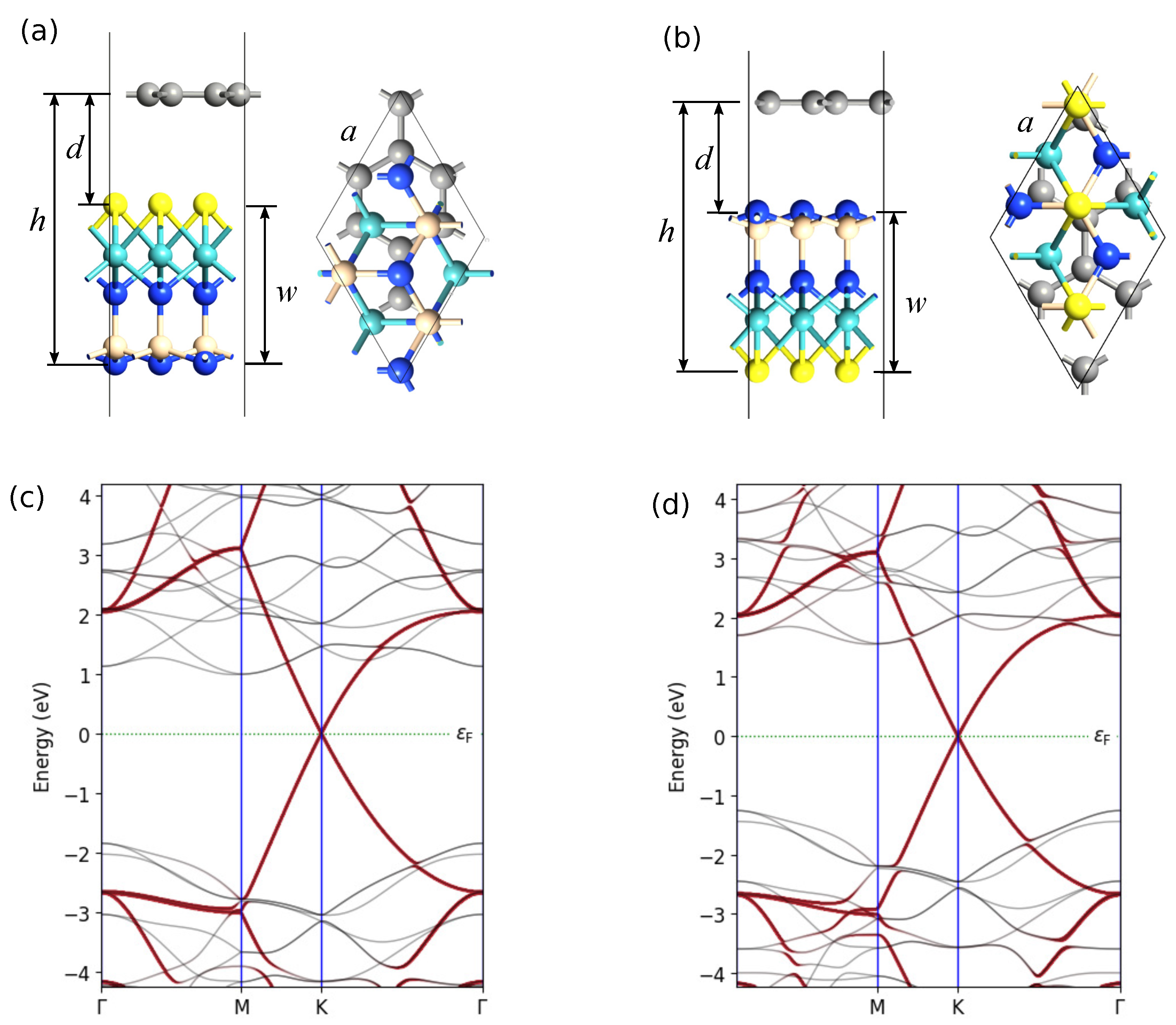
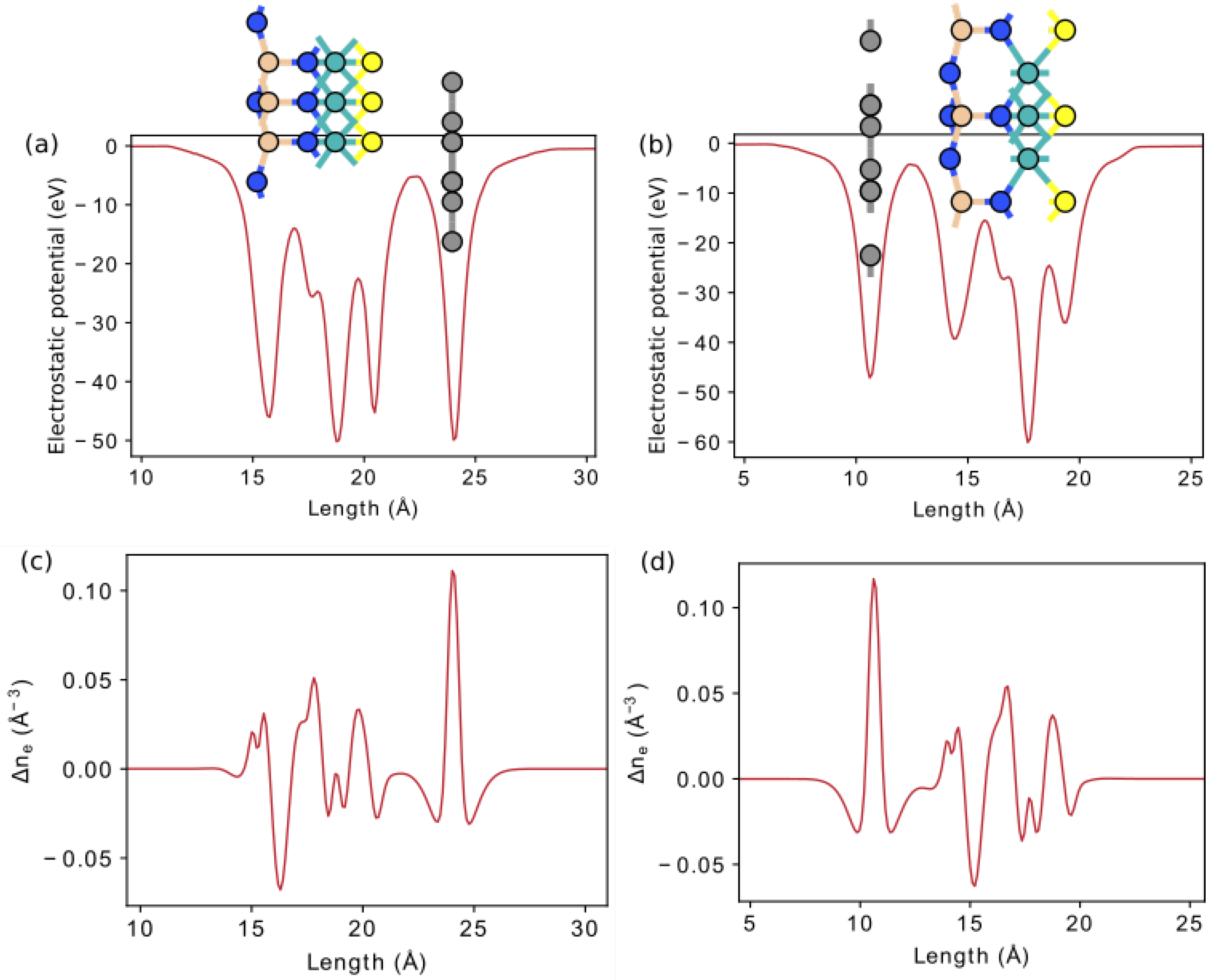

| a, Å | , Å | , Å | , Å | , Å | h, Å | , eV/atom | |
|---|---|---|---|---|---|---|---|
| SWSiN | 2.999 | 2.39 | 2.12 | 1.77 | 1.80 | 5.13 | |
| SeWSiN | 3.042 | 2.55 | 2.13 | 1.77 | 1.82 | 5.29 | |
| TeWSiN | 3.113 | 2.72 | 2.15 | 1.77 | 1.85 | 5.44 | |
| SWGeN | 3.105 | 2.47 | 2.14 | 1.77 | 1.85 | 5.08 | |
| SeWGeN | 3.132 | 2.56 | 2.15 | 1.91 | 1.90 | 5.47 | |
| TeWGeN | 3.105 | 2.72 | 2.14 | 1.77 | 1.85 | 5.43 | |
| SMoGeN | 3.127 | 2.27 | 2.14 | 1.77 | 1.86 | 4.67 | |
| SeMoGeN | 3.125 | 2.54 | 2.14 | 1.90 | 1.90 | 5.44 | |
| TeMoGeN | 3.193 | 2.72 | 2.16 | 1.91 | 1.93 | 5.60 | |
| SMoSiN [9] | 2.989 | 2.38 | 2.11 | 1.76 | 1.80 | 5.12 | |
| SeMoSiN [9] | 3.034 | 2.53 | 2.12 | 1.77 | 1.83 | 5.27 | |
| TeMoSiN [9] | 3.105 | 2.72 | 2.14 | 1.77 | 1.85 | 5.43 |
| E, eV | E, eV | E, eV | , meV | , meV | , eV | , D | |
|---|---|---|---|---|---|---|---|
| SWSiN | 2.37 | 2.98 | 2.67 | 475 | 254 | 0.65 | 0.238 |
| SeWSiN | 2.01 | 2.54 | 2.26 | 329 | 454 | 1.60 | 0.403 |
| TeWSiN | 1.32 | 1.95 | 1.62 | 410 | 406 | 2.05 | 0.530 |
| SWGeN | 1.61 | 2.12 | 2.03 | 523 | 219 | 0.42 | 0.224 |
| , N/m | , N/m | , N/m | Y, N/m | ||
|---|---|---|---|---|---|
| SWSiN | 339.43 | 74.59 | 131.88 | 323.04 | 0.22 |
| SeWSiN | 339.47 | 69.79 | 130.83 | 325.12 | 0.21 |
| TeWSiN | 312.24 | 56.95 | 130.34 | 301.85 | 0.18 |
| SWGeN | 274.17 | 68.64 | 100.68 | 256.99 | 0.25 |
| MoS | 128.40 | 32.60 | – | 120.10 | 0.25 |
| graphene | 352.00 | 62.60 | – | 340.80 | 0.18 |
| h, Å | d, Å | w, Å | a, Å | |
|---|---|---|---|---|
| graphene/S-MoSiN | 8.771 | 3.597 | 5.1739 | 5.080 |
| S-MoSiN/graphene | 8.736 | 3.564 | 5.1725 | 5.081 |
Publisher’s Note: MDPI stays neutral with regard to jurisdictional claims in published maps and institutional affiliations. |
© 2022 by the authors. Licensee MDPI, Basel, Switzerland. This article is an open access article distributed under the terms and conditions of the Creative Commons Attribution (CC BY) license (https://creativecommons.org/licenses/by/4.0/).
Share and Cite
Meftakhutdinov, R.M.; Sibatov, R.T. Janus Type Monolayers of S-MoSiN2 Family and Van Der Waals Heterostructures with Graphene: DFT-Based Study. Nanomaterials 2022, 12, 3904. https://doi.org/10.3390/nano12213904
Meftakhutdinov RM, Sibatov RT. Janus Type Monolayers of S-MoSiN2 Family and Van Der Waals Heterostructures with Graphene: DFT-Based Study. Nanomaterials. 2022; 12(21):3904. https://doi.org/10.3390/nano12213904
Chicago/Turabian StyleMeftakhutdinov, Ruslan M., and Renat T. Sibatov. 2022. "Janus Type Monolayers of S-MoSiN2 Family and Van Der Waals Heterostructures with Graphene: DFT-Based Study" Nanomaterials 12, no. 21: 3904. https://doi.org/10.3390/nano12213904






